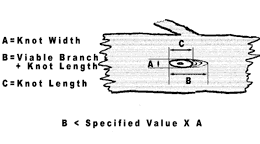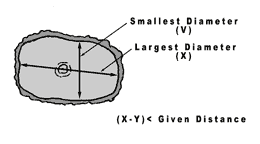This grade specification and measurement manual has been compiled by Woodnet from a variety of sources and is intended to act as a reference. Please note that these are only a guideline and users are encouraged to check by which method a buyer or seller has derived their grade specifications.
1. Measuring Log Length
The length of the log is the distance measured along the shortest straight distance between the cut ends as shown in the diagram below. Measurements should be made to two decimal places (e.g. 4.95, 5.50m)

2. Measuring Log Sweep
Sweep is defined as a predominant curve in a single direction along a log.
Deflection Method
Sweep is measured over the length of the log except if a log specification indicates otherwise, and the allowable deflection must not exceed a proportion of the small-end-diameter (S.E.D). For example 1/4 SED
It is measured by running a tape tightly across the inner side of the bend and measuring the distance between the log and the tape at the widest point as shown in the diagram below. If tape is running outside of the bark then the measurement should be taken from outside of the bark and vice versa.
.gif)
3. Measuring Wobble
Wobble is where two or more deviations occur on the same plane along the length of the log. Wobble is based on a proportion of the S.E.D (small end diameter) measurement. The greatest deflection along the log from high point to high point is measured as shown in the diagram below (also refer measuring sweep)

4. Measuring Multiple Sweep
Multiple sweep is different from wobble in that two or more deviations occur in more than one plane. You can measure the deviation in each plane the same way as measured for wobble and add them together. The sum of the deviations should not exceed a proportion of the S.E.D (small end diameter)

5. Nodal Swelling
Nodal swelling occurs around a branch node (includes nodal swelling in pruned logs).
This can be measured as the maximum distance between the top of the swelling (not the branch stub) parallel to the overall taper of the log and the S.E.D side of the log where it resumes its unswelled shape. It is recommended that the measurement is made using a straight edge of some kind and a short tape as shown in the diagram below.

6. Measuring Diameter
Minimum Small End Diameter
The minimum S.E.D is the shortest distance through the center of the log small end as shown below (note pith may not necessarily be the center of the log)
S.E.D. is often a crucial measurement in defining log grades both in size and as a reference to other measurements such as sweep or wobble and should be measured accurately to avoid contract discussions regarding acceptable log grades.
.gif)
Measuring Large End Diameter
LED is the greatest distance through the center of the log large end as shown below (note pith may not necessarily be the center of the log).
.gif)
Measuring other Diameters
This includes any diameter that is taken at a specified point on the log. Some examples of this are the maximum diameter measured at the widest point on the log, minimum diameter measured at the narrowest point on the log. Bark must be removed at point of measurement. The diameter is measured using a caliper or equivalent device. Note that in some cases the maximum diameter may be greater than the large end diameter.
.gif)
7. Measuring and Defining Knots
A knot is where a branch has been cut off flush with the stem. There are two methods of measuring knots and both of these are explained below.
The first method is the more widely used approach and in both methods the cut face is not included in the measurement.
Right angles to the log length
The knot is measured at right angles to the axis of the log at the maximum dimension. Ensure that the cut face is not included in this measurement.
.gif)
Maximum Dimension
Measure the knot at its maximum dimension ensuring that the cut face is not included in the measurement.
.gif)
8. Measuring Spike Knots
Spike knots are the result of acutely angled branches.
They are unattractive to some buyers as they are more likely to fall out of the board once it is cut and dried leaving a hole in the timber.
One method of measurement is to measure the length of the knot parallel to the log axis and add to the length of the visible branch. The sum of these should be less than the specified value times the width of the knot (measured using knot measurement techniques)

9. Measuring Knot Clusters
Knot clusters are the concentration of knots within a whorl. To measure these, a loggers tape should be wrapped around the whorl, perpendicular to the log axis. The tape is placed at a point which incudes the greatest amount of knots. Measure using the knot measuring method, all knots that the tape touches. The measurements are summed and should not exceed a percentage of the diameter (outside bark) at the point where the tape is placed.
This measurement is often relevant to the out turn of veneer grade product

10. Cut face
Cut face is the result of nodal swelling removal around a knot or knots, which has left a cut surface on the log. This is larger than the branch(es) diameter. The cut face at right angles to the axis of the log at its widest point.

11. Scarf Face
Scarf face is the part of the scarf top cut that is retained on the log. The scarf face should be measured as a length along the axis of the log.

12. Slabbing
Slabbing is the loss of wood from the side of the log usually caused during felling.
This has the effect of reducing the amount of usable log a buyer can utilise and dependent on the type of debarker used can sometimes not be debarked without causing further damage of the log.

13. Measuring Fluting
Fluting is a depression to the circumference of a log due to creasing of the bark or the growing together of buttresses. It is measured as a maximum depth form a straight line as shown below

14. Out of Round (Ovality)
Ovality of a log is the variation between the shortest and longest diameter at one end.
This can be measured by subtracting the smallest diameter from the largest diameter and the resulting value not exceeding a given value. Note the smallest and largest diameter do not need to be at right angles.

|